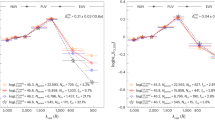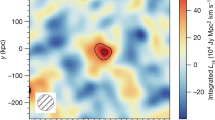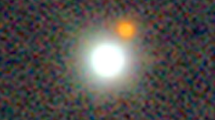Abstract
UNIFIED models1–3 of radio-loud quasars and powerful radio galaxies suggest that they are intrinsically similar objects observed from different angles. This can be tested by comparing the isotropically emitted radiation from the spatially extended nebulae surrounding the nuclei; the unified models predict that the intensities of these emissions should be comparable for the two classes of object. But when this prediction was examined4 for the [O III] 5,007-Å emission line, it was found that quasar [O III] luminosities significantly exceed those of otherwise similar radio galaxies. We have measured the spatially integrated [OII] 3,727-Å emission-line luminosities for a number of quasars and radio galaxies taken from the 3C catalogue. Supplementing our data with values from the literature, we find no systematic difference in the [O II] luminosities. We argue that this emission is indeed isotropic, and that our results are consistent with the unification hypothesis; the [O III] line, on the other hand, may still have a significant component from the nuclear region, and thus be subject to pronounced anisotropic obscuration.
This is a preview of subscription content, access via your institution
Access options
Subscribe to this journal
Receive 51 print issues and online access
$199.00 per year
only $3.90 per issue
Buy this article
- Purchase on Springer Link
- Instant access to full article PDF
Prices may be subject to local taxes which are calculated during checkout
Similar content being viewed by others
References
Antonucci, R. R. J. & Miller, J. S. Astrophys. J. 297, 621–632 (1985).
Scheuer, P. A. G. in Superluminal Radio Sources (eds Zensus, J. A. & Pearson, T. J.) 104–113 (Cambridge Univ. Press, 1987).
Barthel, P. D. Astrophys. J. 336, 606–611 (1989).
Jackson, N. & Browne, I. W. A. Nature 343, 43–45 (1990).
Padovani, P. & Urry, C. M. Astrophys. J. 387, 449–457 (1992).
Barthel, P. D., Hooimeyer, J. R., Schilizzi, R. T., Miley, G. K. & Preuss, E. Astrophys. J. 336, 601–605 (1989).
Tadhunter, C. N. in New Windows to the Universe Vol. 2 (eds Sanchez F. & Vasquez, M.) 175–192 (Cambridge Univ. Press, 1990).
Antonucci, R. Nature 299, 605–606 (1982).
Goodrich, R. W. & Cohen, M. H. Astrophys. J. 391, 623–628 (1992).
Antonucci, R. & Barvainis, R. Astrophys. J. 363, L17–L20 (1990).
Djorgovski S., Weir, N., Matthews, K. & Graham, J. R. Astrophys. J. 372, L67–L70 (1991).
Jackson, N. in Physics of Active Galactic Nuclei (eds Duschl, W. J. & Wagner, S. J.) 612–617 (Springer, Berlin, 1992).
Heckman, T. M., Chambers, K. C. & Postman, M. Astrophys. J. 391, 39–47 (1992).
Pier, E. & Krolik, J. Astrophys. J. 401, 99–109 (1992).
Osterbrock, D. Astrophysics of Gaseous Nebulae and Active Galactic Nuclei (University Science Books, Mill Valley, 1989).
Browne, I. W. A. & Jackson, N. in Physics of Active Galactic Nuclei (eds Duschl W. J. & Wagner, S. J.) 618–635 (Springer, Berlin, 1992).
Rawlings, S. & Saunders, R. Nature 349, 138–140 (1991).
Spinrad, H. Publs. astr. Soc. Pacif. 98, 269–284 (1986).
Spinrad, H., Djorgovski, S., Marr, J. & Aguilar, L. Publs. Astr. Soc. Pacif. 97, 932–961 (1985).
Hough, D. H. & Readhead, A. C. S. Astr. J. 98, 1208–1225 (1989).
McCarthy, P. J. thesis, Univ. California, Berkeley (1988).
Jackson, N. & Browne, I. W. A. Mon. Not. R. astr. Soc. 250, 414–421 (1991).
Saunders, R., Baldwin, J. E., Rawlings, S., Warner, P. J. & Miller, L. Mon. Not. R. astr. Soc. 238, 777–790 (1989).
Baum, S. A. & Heckman, T. M. Astrophys. J. 336, 702–771 (1989).
Stockton, A. & MacKenty, J. W. Astrophys. J. 316, 584–596 (1987).
Robinson, A., Binette, L., Fosbury, R. A. E. & Tadhunter, C. N. Mon. Not. R. astr. Soc. 227, 97–114 (1987).
Vestergaard, M. & Barthel, P. D. Astr. J. 105, 456 (1993).
Author information
Authors and Affiliations
Rights and permissions
About this article
Cite this article
Hes, R., Barthel, P. & Fosbury, R. Support for a unified model of radio galaxies and quasars from isotropic [OII] emission. Nature 362, 326–328 (1993). https://doi.org/10.1038/362326a0
Received:
Accepted:
Published:
Issue Date:
DOI: https://doi.org/10.1038/362326a0
This article is cited by
-
Radio AGN in the local universe: unification, triggering and evolution
The Astronomy and Astrophysics Review (2016)
Comments
By submitting a comment you agree to abide by our Terms and Community Guidelines. If you find something abusive or that does not comply with our terms or guidelines please flag it as inappropriate.



